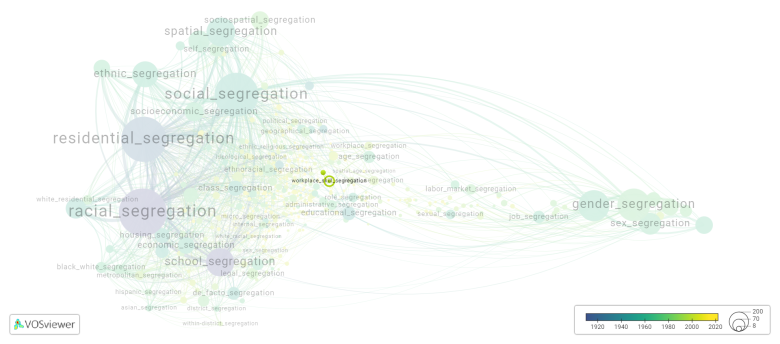Workplace skill segregation: Difference between revisions
(Creating page) |
(Creating page) |
||
| (12 intermediate revisions by the same user not shown) | |||
| Line 1: | Line 1: | ||
===== Date and country of first publication<ref>Date and country of first publication as informed by the Scopus database (December 2023).</ref>===== | |||
2008<br> | |||
Spain | |||
===== Definition ===== | |||
Workplace skill segregation refers to the separation or categorization of employees based on their skills or abilities. This can lead to inequality and exclusion in the workplace as certain groups are marginalized or undervalued based on their skill set. | Workplace skill segregation refers to the separation or categorization of employees based on their skills or abilities. This can lead to inequality and exclusion in the workplace as certain groups are marginalized or undervalued based on their skill set. | ||
| Line 8: | Line 10: | ||
To address workplace skill segregation, companies should actively promote inclusivity and diversity in hiring and promotion practices. This can involve providing training and development opportunities for employees to improve their skills and abilities, as well as creating a culture of respect and recognition for all employees regardless of their skill level. Additionally, organizations should strive to create a collaborative and inclusive work environment where all employees feel valued and appreciated for their contributions. | To address workplace skill segregation, companies should actively promote inclusivity and diversity in hiring and promotion practices. This can involve providing training and development opportunities for employees to improve their skills and abilities, as well as creating a culture of respect and recognition for all employees regardless of their skill level. Additionally, organizations should strive to create a collaborative and inclusive work environment where all employees feel valued and appreciated for their contributions. | ||
==See also== | ==See also== | ||
==Related segregation forms== | |||
Workplace skill segregation is frequently discussed in the literature with the following segregation forms: | |||
[[social segregation]] | |||
[[File:workplace_skill_segregation.png|780x780px]] | |||
This visualization is based on the study [[Segregation_Wiki:About| The Multidisciplinary Landscape of Segregation Research]]. | |||
For the complete network of interrelated segregation forms, please refer to: | |||
* [https://tinyurl.com/2235lkhw First year of publication] | |||
* [https://tinyurl.com/2d8wg5n3 Louvain clusters] | |||
* [https://tinyurl.com/223udk5r Betweenness centrality] | |||
* [https://tinyurl.com/244d8unz Disciplines in which segregation forms first emerged (Scopus database).] | |||
==References== | ==References== | ||
== | ==Notes== | ||
<references /> | |||
{{NoteAI}} | |||
==Workplace skill segregation appears in the following literature== | |||
Cabrales A. | Cabrales A., Calvó-Armengol A. (2008). Interdependent preferences and segregating equilibria. ''Journal of Economic Theory'', ''139''(1), 99-113. https://doi.org/10.1016/j.jet.2007.08.003 | ||
Cabrales A. ( | Cabrales A., Calvó-Armengol A., Pavoni N. (2008). Social preferences, skill segregation, and wage dynamics. ''Review of Economic Studies'', ''75''(1), 65-98. https://doi.org/10.1111/j.1467-937X.2007.00460.x | ||
Cabrales A | Cabrales A. (201). The causes and economic consequences of envy. ''SERIEs'', ''1''(4), 371-386. Springer Verlag.https://doi.org/10.1007/s13209-010-0028-1 | ||
Latest revision as of 07:17, 16 October 2024
Date and country of first publication[1][edit | edit source]
2008
Spain
Definition[edit | edit source]
Workplace skill segregation refers to the separation or categorization of employees based on their skills or abilities. This can lead to inequality and exclusion in the workplace as certain groups are marginalized or undervalued based on their skill set.
Skill segregation can also lead to a lack of diversity and innovation within the company, as different perspectives and ideas may be overlooked or dismissed. It can also create a culture of competition and division among employees, rather than collaboration and cooperation.
To address workplace skill segregation, companies should actively promote inclusivity and diversity in hiring and promotion practices. This can involve providing training and development opportunities for employees to improve their skills and abilities, as well as creating a culture of respect and recognition for all employees regardless of their skill level. Additionally, organizations should strive to create a collaborative and inclusive work environment where all employees feel valued and appreciated for their contributions.
See also[edit | edit source]
Related segregation forms[edit | edit source]
Workplace skill segregation is frequently discussed in the literature with the following segregation forms:
This visualization is based on the study The Multidisciplinary Landscape of Segregation Research.
For the complete network of interrelated segregation forms, please refer to:
References[edit | edit source]
Notes[edit | edit source]
- ↑ Date and country of first publication as informed by the Scopus database (December 2023).
At its current state, this definition has been generated by a Large Language Model (LLM) so far without review by an independent researcher or a member of the curating team of segregation experts that keep the Segregation Wiki online. While we strive for accuracy, we cannot guarantee its reliability, completeness and timeliness. Please use this content with caution and verify information as needed. Also, feel free to improve on the definition as you see fit, including the use of references and other informational resources. We value your input in enhancing the quality and accuracy of the definitions of segregation forms collectively offered in the Segregation Wiki ©.
Workplace skill segregation appears in the following literature[edit | edit source]
Cabrales A., Calvó-Armengol A. (2008). Interdependent preferences and segregating equilibria. Journal of Economic Theory, 139(1), 99-113. https://doi.org/10.1016/j.jet.2007.08.003
Cabrales A., Calvó-Armengol A., Pavoni N. (2008). Social preferences, skill segregation, and wage dynamics. Review of Economic Studies, 75(1), 65-98. https://doi.org/10.1111/j.1467-937X.2007.00460.x
Cabrales A. (201). The causes and economic consequences of envy. SERIEs, 1(4), 371-386. Springer Verlag.https://doi.org/10.1007/s13209-010-0028-1

